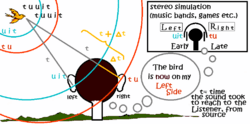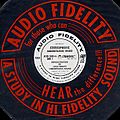Stereophonic sound facts for kids
Stereo sound, or stereophonic sound, is a way of making sound that makes it seem like the sound is coming from different directions. Imagine you're listening to music, and you can hear the drums on one side and the guitar on the other. That's stereo! It makes the sound feel more real, like you're actually there.
This usually works by using two or more separate sound channels. These channels play through two or more loudspeakers or stereo headphones. This setup makes you feel like the sound is coming from various places, just like how you hear things in real life. So, even systems with many speakers, like "surround-sound" systems, are a type of stereo.
Stereo sound is different from "mono" (or monophonic) sound. With mono sound, all the audio seems to come from one spot, usually right in front of you. Think of it like seeing with only one eye – everything looks flat. Stereo sound is like seeing with both eyes, giving you depth. Stereo sound has been very common since the 1970s. You hear it in radio, TV, recorded music, on the internet, and in movies.
Contents
What is Stereo Sound?
Stereo sound uses at least two separate sound signals, called "channels." Each channel carries slightly different information about the sound. When these two channels are played through two different speakers (one on your left, one on your right), your brain puts them together. This makes you feel like the sound is coming from different places around you.
For example, if a singer's voice is mostly in the left channel, it will sound like they are standing on your left. If a drum beat is spread across both channels, it will sound like it's in the middle. This trick makes the sound much more exciting and realistic than mono sound, where everything sounds like it's coming from one spot.
How Stereo Makes Sound Real
Our ears are on different sides of our heads. This helps us figure out where sounds are coming from in the real world. If a sound comes from your left, it reaches your left ear a tiny bit sooner and is a tiny bit louder than in your right ear. Your brain uses these small differences to know the sound's direction.
Stereo sound systems copy this natural process. They record or create sounds with these small differences for each channel. When you listen, your ears pick up these differences from the left and right speakers. Your brain then tricks you into thinking the sound is moving or coming from a specific place, even though it's just coming from two speakers.
Stereo vs. Mono Sound
- Mono Sound: This is like a single stream of sound. All the sounds are mixed together into one channel. If you play mono sound through two speakers, both speakers play the exact same sound. It sounds flat, like it's coming from a single point. Old radios and early recordings often used mono sound.
- Stereo Sound: This uses at least two separate channels. Each channel has slightly different sounds. When played through two speakers, these differences create a feeling of space and direction. It makes music feel wider and more alive. Most modern music, movies, and TV shows use stereo sound.
History of Stereo Sound
The idea of stereo sound is actually quite old! People started experimenting with it over a hundred years ago.
Early Experiments
One of the first public demonstrations of stereo sound was in 1881. A French engineer named Clément Ader used a system called the théatrophone. He placed telephone transmitters on the stage of the Paris Opera. Listeners could hear the opera through two separate telephone lines, one for each ear. This gave them a sense of the performers moving on stage.
Later, in the 1930s, Bell Labs in the United States did more important work on stereo sound. They showed how it could make movies and music sound much better. They even demonstrated a "three-channel" system, which was very advanced for its time.
Stereo Becomes Popular
For a long time, stereo sound was mostly used in movies and special demonstrations. It wasn't until the late 1950s and early 1960s that stereo records and radio broadcasts became common for everyone.
- In 1958, the first stereo record albums were sold. This was a big deal because people could finally enjoy stereo music at home.
- Around the same time, FM radio stations started broadcasting in stereo. This meant you could listen to your favorite songs with that cool, wide stereo sound right from your radio.
Since then, stereo sound has become the standard for almost all audio entertainment, from your phone to your home theater system.
Images for kids
See also
 In Spanish: Sonido estereofónico para niños
In Spanish: Sonido estereofónico para niños







